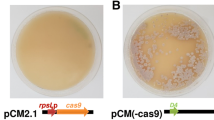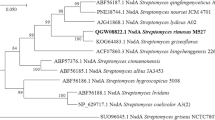Abstract
Acremonium chrysogenum is an important fungal strain used for cephalosporin C production. Many efforts have been made to develop versatile genome-editing tools to better understand the mechanism of A. chrysogenum. Here, we developed a feasible and efficient CRISPR/Cas9 system. Two genes responsible for the synthesis of yellow pigments (sorbicillinoids) were chosen as targets, and plasmids expressing both the Cas9 protein and single-guide RNAs were constructed. After introducing the plasmids into the protoplasts of A. chrysogenum, 83 to 93% albino mutants harboring the expected genomic alteration, on average, were obtained. We have generated two mutant strains that respectively disrupt sorA and sorB by flexible CRISPR/Cas9 system. We further confirmed that the sorbicillinoid biosynthetic gene cluster is regulated by an autoinduction mechanism. This work will lay a solid foundation for gene function research and regulation in the sorbicillinoid biosynthetic pathway.






Similar content being viewed by others
Abbreviations
- CRISPR/Cas9:
-
Clustered regularly interspaced short palindromic repeats/Cas9
- sgRNAs:
-
Single-guide RNAs
- RGR :
-
Ribozyme-gRNA-Ribozyme
- HH:
-
Hammerhead
- HDV:
-
Hepatitis delta virus
- PKS:
-
Polyketide synthase
- CGMCC:
-
China General Microbiological Culture Collection Center
- HR:
-
Highly reducing
- NR:
-
Non-reducing
References
Terfehr, D., Dahlmann, T. A., Specht, T., & Zadra, I. (2014). Genome sequence and annotation of Acremonium chrysogenum, producer of the β-lactam antibiotic cephalosporin C. Genome Announcements, 2, 5.
Poggeler, S., & Kuck, U. (2006). Highly efficient generation of signal transduction knockout mutants using a fungal strain deficient in the mammalian ku70 ortholog. Gene, 378, 1–10.
Hoff, B., Kamerewerd, J., Sigl, C., & Zadra, I. (2010). Homologous recombination in the antibiotic producer Penicillium chrysogenum: strain DeltaPcku70 shows up-regulation of genes from the HOG pathway. Applied Microbiology and Biotechnology, 85(4), 1081–1094.
Bloemendal, S., Loper, D., Terfehr, D., & Kopke, K. (2014). Tools for advanced and targeted genetic manipulation of the beta-lactam antibiotic producer Acremonium chrysogenum. Journal of Biotechnology, 169, 51–62.
Katayama, T., Tanaka, Y., Okabe, T., & Nakamura, H. (2016). Development of a genome editing technique using the CRISPR/Cas9 system in the industrial filamentous fungus Aspergillus oryzae. Biotechnology Letters, 38(4), 637–642.
Zhang, F., Wen, Y., & Guo, X. (2014). CRISPR/Cas9 for genome editing: progress, implications and challenges. Human Molecular Genetics, 23(R1), R40–R46.
Gao, Y., & Zhao, Y. (2014). Self-processing of ribozyme-flanked RNAs into guide RNAs in vitro and in vivo for CRISPR-mediated genome editing. Journal of Integrative Plant Biology, 56(4), 343–349.
Abe, N., Yamamoto, K., & Hirota, A. (2000). Novel fungal metabolites, demethylsorbicillin and oxosorbicillinol, isolated from Trichoderma sp. USF-2690. Bioscience, Biotechnology, and Biochemistry, 64(3), 620–622.
Guzman-Chavez, F., Salo, O., Nygard, Y., & Lankhorst, P. P. (2017). Mechanism and regulation of sorbicillin biosynthesis by Penicillium chrysogenum. Microbial Biotechnology, 10(4), 958–968.
Harned, A. M., & Volp, K. A. (2011). The sorbicillinoid family of natural products: Isolation, biosynthesis, and synthetic studies. Natural Product Reports, 28(11), 1790–1810.
Du, L., Zhu, T., Li, L., & Cai, S. (2009). Cytotoxic sorbicillinoids and bisorbicillinoids from a marine-derived fungus Trichoderma sp. Chemical & Pharmaceutical Bulletin, 57(2), 220–223.
Nicoletti, R., & Trincone, A. (2016). Bioactive compounds produced by strains of Penicillium and Talaromyces of marine origin. Marine Drugs, 14(2), 37.
Druzhinina, I. S., Kubicek, E. M., & Kubicek, C. P. (2016). Several steps of lateral gene transfer followed by events of ‘birth-and-death’ evolution shaped a fungal sorbicillinoid biosynthetic gene cluster. BMC Evolutionary Biology, 16(1), 269.
Derntl, C., Guzman-Chavez, F., Mello-De-Sousa, T. M., & Busse, H. J. (2017). In vivo study of the sorbicillinoid gene cluster in Trichoderma reesei. Frontiers in Microbiology, 8, 2037.
Wang, H., Pan, Y., Hu, P., & Zhu, Y. (2014). The autophagy-related gene Acatg1 is involved in conidiation and cephalosporin production in Acremonium chrysogenum. Fungal Genetics and Biology, 69, 65–74.
Schmittgen, T. D., & Livak, K. J. (2007). Analyzing real-time PCR data by the comparative C(T) method. Nature Protocols, 3, 1101–1108.
Hu, Y., & Zhu, B. (2016). Study on genetic engineering of Acremonium chrysogenum, the cephalosporin C producer. Synthetic and Systems Biology, 1(3), 143–149.
Xie, K., & Yang, Y. (2013). RNA-guided genome editing in plants using a CRISPR-Cas system. Molecular Plant, 6(6), 1975–1983.
DiCarlo, J. E., Norville, J. E., Mali, P., & Rios, X. (2013). Genome engineering in Saccharomyces cerevisiae using CRISPR-Cas systems. Nucleic Acids Research, 41(7), 4336–4343.
Liu, R., Chen, L., Jiang, Y., & Zhou, Z. (2015). Efficient genome editing in filamentous fungus Trichoderma reesei using the CRISPR/Cas9 system. Cell Discovery, 1(1), 15007.
Fuller, K. K., Chen, S., Loros, J. J., & Dunlap, J. C. (2015). Development of the CRISPR/Cas9 system for targeted gene disruption in Aspergillus fumigatus. Eukaryotic Cell, 14(11), 1073–1080.
Arazoe, T., Miyoshi, K., Yamato, T., & Ogawa, T. (2015). Tailor-made CRISPR/Cas system for highly efficient targeted gene replacement in the rice blast fungus. Biotechnology and Bioengineering, 112(12), 2543–2549.
Matsu-Ura, T., Baek, M., Kwon, J., & Hong, C. (2015). Efficient gene editing in Neurospora crassa with CRISPR technology. Fungal Biology and Biotechnology, 2(1), 4.
Pohl, C., Kiel, J. A. K. W., Driessen, A. J. M., & Bovenberg, R. A. L. (2016). CRISPR/Cas9 based genome editing of Penicillium chrysogenum. ACS Synthetic Biology, 5(7), 754–764.
Fahad, A. A., Abood, A., Fisch, K. M., & Osipow, A. (2013). Oxidative dearomatisation: the key step of sorbicillinoid biosynthesis. Chemical Science, 5(2), 523–527.
Abe, N., & Hirota, A. (2002). Chemical studies of the radical scavenging mechanism of bisorbicillinol using the 1,1-diphenyl-2-picrylhydrazyl radical. Chemical Communications, 6, 662–663.
Derntl, C., Rassinger, A., Srebotnik, E., & Mach, L. (2016). Identification of the main regulator responsible for synthesis of the typical yellow pigment produced by Trichoderma reesei. Applied and Environmental Microbiology, 82(20), 6247–6257.
Acknowledgements
We acknowledge our colleague Dr. Liming Ouyang at ECUST China for her constructive discussion on this work.
Funding
This work was financially subsidized by NOW-MoST Joint Program (2013DFG32630) and partially supported by National Basic Research Program (973 program 2012CB721006).
Author information
Authors and Affiliations
Corresponding author
Ethics declarations
We confirm that this manuscript has not been published elsewhere and is not under consideration by another journal. All authors have approved the manuscript and agree with submission to Applied Biochemistry and Biotechnology.
Conflict of Interest
The authors declare that they have no competing interests.
Additional information
Publisher’s Note
Springer Nature remains neutral with regard to jurisdictional claims in published maps and institutional affiliations.
Electronic Supplementary Material
ESM 1
(DOCX 19 kb)
Rights and permissions
About this article
Cite this article
Chen, G., Chu, J. Characterization of Two Polyketide Synthases Involved in Sorbicillinoid Biosynthesis by Acremonium chrysogenum Using the CRISPR/Cas9 System. Appl Biochem Biotechnol 188, 1134–1144 (2019). https://doi.org/10.1007/s12010-019-02960-z
Received:
Accepted:
Published:
Issue Date:
DOI: https://doi.org/10.1007/s12010-019-02960-z




